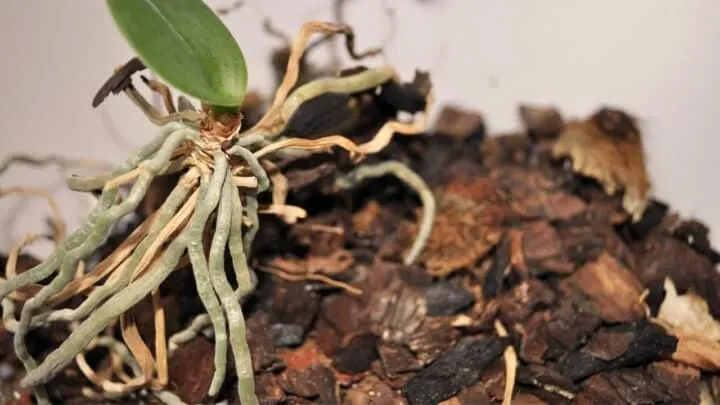Orchid bark is not hard to find and is neither a sweet confection nor bark from an orchid.
A visit to your neighborhood hardware store or garden center will likely yield a bag or two, and I guarantee you can’t eat it. A goat would be hard-pressed to do so, and they love fiber.
The basic blend is a combination of fir bark and other organic materials that closely resemble an orchids’ natural habitat. Think about where an orchid lives in the wild.
Some cling to the bark of trees, while others shyly look up from the forest floor (lady’s slippers, for example), where they plant their roots in the rich soil beneath the forest canopy.
Each variety of orchids has unique needs. Therefore, part of growing orchids successfully means gaining knowledge about each type of plant and then doing what is necessary to bring forth a healthy, blooming specimen.
To learn where to buy orchid bark and what you need to make your own, read on.
Table of Contents
Where to buy orchid bark?
You can buy orchid bark in most garden centers and stores specializing in home improvements. Some growing orchids make their orchid bark mix by buying different ingredients and combining them in various mixes for their other orchids.
What Orchid Bark is
Orchid bark is a soil amendment and substrate medium for orchids, epiphytes, aroids, and other plants that need a medium that drains well, and orchid bark fits that bill.
Another quality it needs is materials that can retain enough moisture to keep the plant’s roots moist.
Although orchids can live fully submerged in water, they can be overwatered if planted in orchid bark or a medium that is too dense and does not allow proper drainage for your plant’s roots.
When growing your orchid in orchid bark, the plant will need a drying-off period between watering. This technique resembles the way an orchid is watered in its natural habitat.
They like to be flooded when watered, and having a medium that drains water quickly helps roots stay moist but not sopping wet.
Full watering moistens the growth medium and then slowly releases the moisture. Your orchid’s roots can then take it in as it evaporates from the bark.
Is Orchid Bark Needed: The Answer
Not all orchids are tree dwellers (Epiphyllous) and a type of air plant. Other orchids are rock plants (Lithophyte) and attach themselves to rocky, mossy terrain.
For orchids that attach themselves to trees, such as the Phalaenopsis orchids, their relationship is symbiotic.
Often, plants that attach themselves to trees are parasitic and can harm the tree. However, that is not an issue with orchids.
The reason an orchid does not harm is that the tree is but a place to anchor itself. Their roots absorb the nutrients they require and take in the carbon dioxide they need to thrive.
So, yes, you do need orchid bark, because even when grown in terrariums and other vessels, orchids need a medium that holds them in place. Orchid bark allows the roots of your plant to spread out.
Making your Own Orchid Bark Mix
Orchid bark mix is not a complicated recipe. Each product you find in the store will have ingredients in varying amounts, and you can mimic the ratios or go your own way and see how your orchid bark mix works with your plants.
If you want to experiment with your mix, you will need to purchase fir bark, which is precisely that, bark from the fir tree.
You can use perlite, charcoal, sphagnum moss, coconut fiber, sticks, and stones (literally) as ingredients in the orchid bark mix.
The objective with orchid bark is not to nourish your plant but to support it in whatever vessel it calls home. The bark also protects the roots and facilitates keeping them damp.
Cover the top layer of the orchid bark thinly with sphagnum moss, help the container your orchid is planted in, and stay hydrated.
Orchid Bark and Its Other Uses
It may not if you buy the premade mix. However, if you purchase separate ingredients and mix up your recipe, the ingredients may have other uses if used alone.
An example of this is perlite, the little white foam-looking substance you see in potting soil.
A mineral that occurs naturally, perlite is packed with minerals that is beneficial to your plants.
Since the source of these minerals is volcanic activity, they have a clay-like texture and release their valuable minerals slowly.
When added to soil, perlite helps retain water and makes the soil loftier, facilitating root growth. So, if you need it for your orchid bark mix, you can also use it for your potted plants and raised beds.
Frequently Asked Questions about Where to Buy Orchid Bark
How often to water an orchid planted in orchid bark?
It would help if you watered your orchid about every seven days. If your fir bark is mixed with extra sphagnum or peat moss, you can go a bit longer between watering. You will learn what your plants like by observance, and it is better to give your orchid too little water, than too much.
Does fir bark have other uses than orchid bark?
Because it holds water so well, fir bark is often mixed with other varieties of bark and used to reduce erosion and soil compaction. In addition, it naturally reduces weeds and retains moisture.

Daniel has been a plant enthusiast for over 20 years. He owns hundreds of houseplants and prepares for the chili growing seasons yearly with great anticipation. His favorite plants are plant species in the Araceae family, such as Monstera, Philodendron, and Anthurium. He also loves gardening and is growing hot peppers, tomatoes, and many more vegetables.


